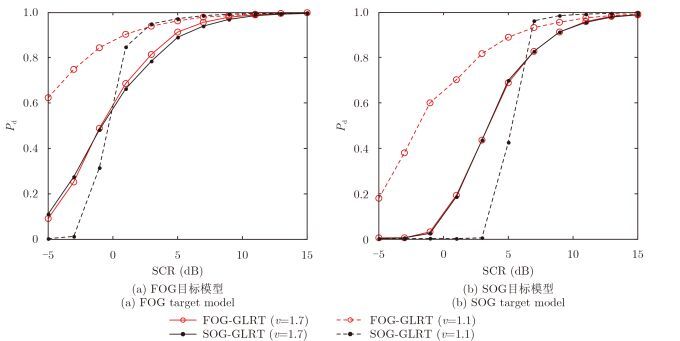| [1] |
何友, 黄勇, 关键, 等.海杂波中的雷达目标检测技术综述[J].现代雷达, 2014, 36(12): 1-9. doi: 10.3969/j.issn.1004-7859.2014.12.001He Y, Huang Y, Guan J, et al.. An overview on radar target detection in sea clutter[J]. Modern Radar, 2014, 36(12): 1-9. doi: 10.3969/j.issn.1004-7859.2014.12.001
|
| [2] |
Ward K, Tough R, and Watts S. Sea Clutter: Scattering, the K-Distribution and Radar Performance, 2nd ed[M]. London: The Institution of Engineering and Technology, 2013.
|
| [3] |
Gini F and Farina A. Vector subspace detection in compound-Gaussian clutter, Part Ⅰ: Surgey and new results[J]. IEEE Transactions on Aerospace and Electronic Systems, 2002, 38(4): 1295-1311. doi: 10.1109/TAES.2002.1145751
|
| [4] |
Conte E, Lops M, and Ricci G. Asymptotically optimum radar detection in compound-Gaussian clutter[J]. IEEE Transactions on Aerospace and Electronic Systems, 1995, 31(2): 617-625. doi: 10.1109/7.381910
|
| [5] |
Gini F. Suboptimum coherent radar detection in a mixture of K-distributed and Gaussian clutter[J]. IEE Proceedings, Radar, Sonar and Navigation, 1997, 144(1): 39-48. doi: 10.1049/ip-rsn:19970967
|
| [6] |
Jin Y and Friedlander B. A CFAR adaptive subspace detector for second-order Gaussian signals[J]. IEEE Transactions on Signal Processing, 2005, 53(3): 871-884. doi: 10.1109/TSP.2004.842196
|
| [7] |
Bon N, Khenchaf A, and Garello R. GLRT subspace detection for range and Doppler distributed targets[J]. IEEE Transactions on Aerospace and Electronic Systems, 2008, 44(2): 678-696. doi: 10.1109/TAES.2008.4560214
|
| [8] |
Liu J, Zhang Z J, Yang Y, et al.. A CFAR adaptive subspace detector for first-order or second-order Gaussian signals based on a single observation[J]. IEEE Transactions on Signal Processing, 2011, 59(11): 5126-5140. doi: 10.1109/TSP.2011.2164073
|
| [9] |
Robey F C, Fuhrman D L, Kelly E J, et al.. A CFAR adaptive matched filter detector[J]. IEEE Transactions on Aerospace and Electronic Systems, 1992, 28(1): 208-216. doi: 10.1109/7.135446
|
| [10] |
Kraut S, Scharf L L, and McWhorter L T. Adaptive subspace detectors[J]. IEEE Transactions on Signal Processing, 2001, 49(1): 1-16. doi: 10.1109/78.890324
|
| [11] |
Kraut S and Scharf L L. The CFAR adaptive subspace detector is a scale-invariant GLRT[J]. IEEE Transactions on Signal Processing, 1999, 47(9): 2538-2541. doi: 10.1109/78.782198
|
| [12] |
Liu W J, Xie W C, Liu J, et al.. Adaptive double subspace signal detection in Gaussian background—Part Ⅰ: Homogeneous environments[J]. IEEE Transactions on Signal Processing, 2014, 62(9): 2345-2357. doi: 10.1109/TSP.2014.2309556
|
| [13] |
Liu W J, Xie W C, Liu J, et al.. Adaptive double subspace signal detection in Gaussian background—Part Ⅱ: Partially homogeneous environments[J]. IEEE Transactions on Signal Processing, 2014, 62(9): 2358-2369. doi: 10.1109/TSP.2014.2309553
|
| [14] |
丁昊, 薛永华, 黄勇, 等.均匀和部分均匀杂波中子空间目标的斜对称自适应检测方法[J].雷达学报, 2015, 4(4): 418-430. http://radars.ie.ac.cn/CN/abstract/abstract277.shtmlDing H, Xue Y H, Huang Y, et al.. Persymmetric adaptive detectors of subspace signals in homogeneous and partially homogeneous clutter[J]. Jounal of Radars, 2015, 4(4): 418-430. http://radars.ie.ac.cn/CN/abstract/abstract277.shtml
|
| [15] |
JIAN T, HE Y, LIAO G S, et al.. Adaptive persymmetric detector of generalised likelihood ratio test in homogeneous environment[J]. IET Signal Processing, 2016, 10(2): 91-99. doi: 10.1049/iet-spr.2015.0200
|
| [16] |
Conte E, Lops M, and Ricci G. Adaptive matched filter detection in spherically invariant noise[J]. IEEE Signal Processing Letters, 1996, 3(8): 248-250. doi: 10.1109/97.511809
|
| [17] |
Conte E and Maio A D. Mitigation techniques for non-Gaussian sea clutter[J]. IEEE Journal of Ocean Engineering, 2004, 29(2): 284-302. doi: 10.1109/JOE.2004.826901
|
| [18] |
Gao Y C, Liao G S, and Liu W J. High resolution radar detection in interference and non-homogeneous noise[J]. IEEE Signal Processing Letters, 2016. DOI: 10.1109/ LSP.2016.2597738.
|
| [19] |
刘明, 水鹏朗.海杂波背景下的组合自适应GLRT-LTD[J].电子与信息学报, 2015, 37(12): 2834-2990. http://www.cnki.com.cn/Article/CJFDTOTAL-DZYX201512028.htmLiu M and Shui P L. Combined adaptive GLRT-LTD against sea clutter[J]. Journal of Electronics & Information Technology, 2015, 37(12): 2834-2990. http://www.cnki.com.cn/Article/CJFDTOTAL-DZYX201512028.htm
|
| [20] |
GAO Y C, LIAO G S, ZHU S Q, et al.. A persymmetric GLRT for adaptive detection in compound-Gaussian clutter with random texture[J]. IEEE Signal Processing Letters, 2013, 20(6): 615-618. doi: 10.1109/LSP.2013.2259232
|
| [21] |
Kong L J, Li N, Cui G L, et al.. Adaptive Bayesian detection for multiple-input multiple-output radar in compound-Gaussian clutter with random texture[J]. IET Radar, Sonar & Navigation, 2016, 10(4): 689-698. https://www.researchgate.net/publication/295257939_Adaptive_Bayesian_detection_for_multiple-input_multiple-output_radar_in_compound-Gaussian_clutter_with_random_texture
|
| [22] |
Balleri A, Nehorai A, and Wang J. Maximum likelihood estimation for compound-Gaussian clutter with inverse Gamma texture[J]. IEEE Transactions on Aerospace and Electronic Systems, 2007, 43(2): 775-780. doi: 10.1109/TAES.2007.4285370
|
| [23] |
Bandiera F, Besson O, and Ricci G. Knowledge-aided covariance matrix estimation and adaptive detection in compound-Gaussian noise[J]. IEEE Transactions on Signal Processing, 2010, 58(10): 5391-5396. doi: 10.1109/TSP.2010.2052922
|
| [24] |
Sangston K J, Gini F, and Greco M S. Coherent radar target detection in heavy-tailed compound-Gaussian clutter[J]. IEEE Transactions on Aerospace and Electronic Systems, 2012, 48(1): 64-77. doi: 10.1109/TAES.2012.6129621
|
| [25] |
Ding H, Guan J, Liu N B, et al.. New spatial correlation models for sea clutter[J]. IEEE Geoscience and Remote Sensing Letters, 2015, 12(9): 1833-1837. doi: 10.1109/LGRS.2015.2430371
|
| [26] |
Gini F and Farina A. Matched subspace CFAR detection of hovering helicopters[J]. IEEE Transactions on Aerospace and Electronic Systems, 1999, 35(4): 1293-1305. doi: 10.1109/7.805446
|
| [27] |
Pulsone N B and Raghavan R S. Analysis of an adaptive CFAR detector in non-Gaussian interference[J]. IEEE Transactions on Aerospace and Electronic Systems, 1999, 35(3): 903-916. doi: 10.1109/7.784060
|
| [28] |
Chan H C. Radar sea-clutter at low grazing angles[J]. IEE Proceedings-F, 1990, 137(2): 102-112. https://www.researchgate.net/publication/3361247_Radar_sea-clutter_at_low_grazing_angles
|



 作者中心
作者中心 专家审稿
专家审稿 责编办公
责编办公 编辑办公
编辑办公

 下载:
下载:









